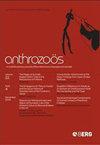狗对问题行为的感知:多维尺度和层次聚类分析的应用
IF 2.3
2区 农林科学
Q2 SOCIOLOGY
引用次数: 8
摘要
各种研究表明,多达40%的狗被贴上了行为问题的标签,至少造成了一些不便。本论文处理主人的感知不适当的狗的行为和这种行为发生的情况的特点。为了实现对狗的问题情况的系统描述,解决了以下问题:狗主人认为哪些日常情况是有问题的?2. 业主对这些有问题的情况有什么看法?35位狗主人被要求描述他们的狗参与的情况,并指出他们认为有问题和烦人的情况。这导致了114种独特的情况,这些情况被分为以下主要类别:攻击行为,不服从行为和反应行为。研究了业主对问题情境的理解。102位业主被要求根据相似性对39种情况进行排序(q排序)。使用多维尺度和层次聚类分析对数据进行分析。多维分析得出了三个维度。结果表明,被认为有问题的情境涉及6类:不服从行为、厌恶行为、攻击行为、恐惧行为、不受控制(兴奋)行为和交配行为。分层聚类分析结果为8类:A -害怕的狗,B -好斗/占主导地位的狗,C -“交配”的狗,D -情绪化的狗,E -无聊/孤独的狗,F -狗的饮食习惯,G -不守规矩的狗,H -不听话的狗。本文章由计算机程序翻译,如有差异,请以英文原文为准。
The Perception of Problematic Behavior in Dogs: Application of Multi-Dimensional Scaling and Hierarchical Cluster Analysis
Various studies show that up to 40% of dogs are labelled as having behavioral problems causing at least some inconvenience. The present paper deals with the owner's perception of inappropriate dog behavior and the characteristics of the situations in which this behavior occurs. To achieve a systematic description of problem situations with dogs, the following questions were addressed: 1. What daily situations do the dog owners consider being problematic? 2. What meaning do owners give to these problematic situations?
Thirty-five dog owners were asked to describe situations in which their dog engaged, and to indicate of these they perceived as problematic and annoying. This resulted in 114 unique situations which were classified into the following main categories: aggressive behavior, disobedient behavior, and reactive behavior. The meanings that owners gave to the problem situations were studied. One hundred and two owners were asked to sort 39 situations according to similarity (Q-sorting). The data were analysed using multidimensional scaling and hierarchical cluster analysis. The multidimensional analysis resulted in three dimensions. These indicated that the situations which are perceived as problematic are related to six categories: disobedient behavior, aversive behavior, aggressive behavior, fearful behavior, uncontrolled (excited) behavior, and mating behavior. The hierarchical cluster analysis resulted in eight clusters: A - The fearful dog, B - The aggressive/dominant dog, C - The “mating“ dog, D - The emotional dog, E - The bored/lonely dog, F - Eating habits of the dog, G - The unruly dog, and H - The disobedient dog.
求助全文
通过发布文献求助,成功后即可免费获取论文全文。
去求助
来源期刊

Anthrozoos
农林科学-兽医学
CiteScore
3.40
自引率
18.80%
发文量
43
审稿时长
>36 weeks
期刊介绍:
A vital forum for academic dialogue on human-animal relations, Anthrozoös is a quarterly, peer-reviewed journal that has enjoyed a distinguished history as a pioneer in the field since its launch in 1987. The key premise of Anthrozoös is to address the characteristics and consequences of interactions and relationships between people and non-human animals across areas as varied as anthropology, ethology, medicine, psychology, veterinary medicine and zoology. Articles therefore cover the full range of human–animal relations, from their treatment in the arts and humanities, through to behavioral, biological, social and health sciences.
 求助内容:
求助内容: 应助结果提醒方式:
应助结果提醒方式:


